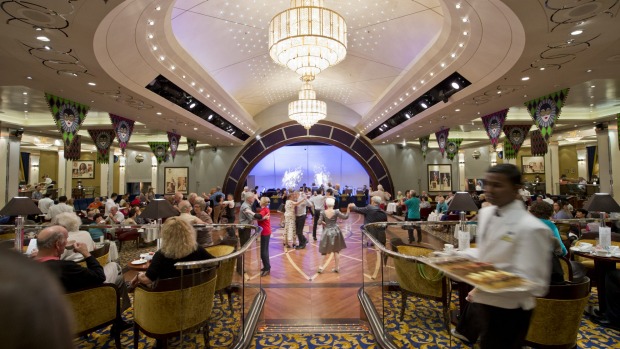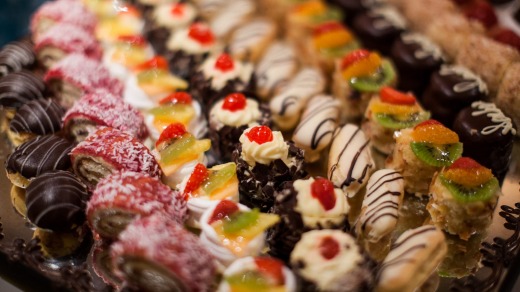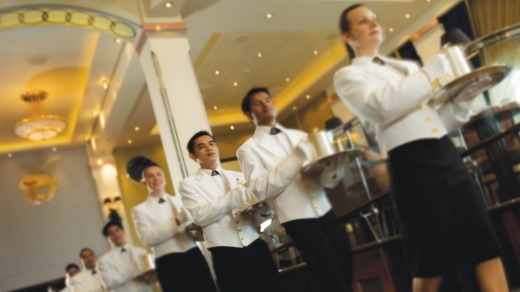
As much as I need my heart-starter espresso coffee first thing in the morning, there is something very pleasing, very stop-the-world-I-want-to-get-off, about taking one's time over the taking of tea.
I'm a sucker for the ritual of afternoon tea as performed by the grand British hotels, and have left only scone crumbs and empty bone-china platters in my wake at London's The Dorchester, The Savoy, The Goring and Claridge's. Especially, of course, at The Ritz, which continues to serve a tidal wave of tea across five separate tea services every single day, with reservations required up to five months in advance.
So the real reason, if you must know, that I went to the trouble of boarding the Queen Mary 2 in Melbourne and accompanying it on its short but splendid voyage to Sydney, was *Insert Afternoon Tea here*. Not to mention the fact that I didn't have to wait five months, a la Ritz, for a scone-scoffing opportunity. In fact, afternoon tea is included in the fare for every day at sea for every one of the QM2's 2620 passengers.

We owe it all, of course, to the hunger pangs of the dashing seventh Duchess of Bedford in the mid-19th century. There being quite a long stretch between the British aristocracy's two main meals a day of breakfast and dinner; my lady took to her rooms at Woburn Abbey mid-afternoon with a pot of revivifying tea and a little snack in order to see herself through. Soon enough, she invited her friends to join her, who all pronounced it a jolly good idea, and the tradition caught on in fashionable society. It entrenched itself in the British psyche, travelling with them to the colonies as a symbol of the civilising effect of the great British Empire.
Luckily, there is no shortage of things to do on the Queen Mary 2 while waiting for one's afternoon tea. The 11-year-old, 151,400 tonne flagship of the Cunard cruise line offers four different outdoor swimming pools, 14 bars and clubs, more than 10 restaurants, a casino, a theatre, a cinema and planetarium, a theatre, a nightclub, a wrap-around promenade deck, golf simulators, a putting green, a half-sized basketball court, a gym, the largest library at sea, and a spa club stretching across two decks.
As the hour approaches, I get a little nervy, pacing up and down the teak wrap-around promenade deck in an effort to make more internal cake-room. I've checked out the rather spectacular, double-decker Queen's Room already, with its magnificent crystal chandelier, its statues and portraits of British monarchs and their consorts, and its white-clothed tables for 562 guests around a central wooden dance floor. I've dressed for the occasion in suit and tie, and even shoes. I've boned up on afternoon tea etiquette, so that I know that the savoury food will come first, followed by scones, followed by cakes, eclairs and miniature desserts. I have practised crooking my little pinky finger. I am hungry. I am ready.

At 3.30pm precisely, a bevy of white-gloved and white-jacketed waiters bearing gleaming silver trays descend upon the ballroom with the precision of a military regiment. Weirdly, nobody leaps forward to fell them with rugby tackles; instead remaining politely seated. An elegantly attired harpist springs into action as a waiter approaches our table carrying a handsome china pot of Twinings' special blend of Assam, Ceylon and Kenyan leaves. If that is not to your liking, you have 20 others from which to choose, but me, I'm not going to rock the boat. I'm going with the flow.
And here's where it could have all gone horribly wrong. Because what we're really talking about is a fantasy, a romance, a dance with history, tradition, nostalgia and tea leaves that weaves a magic spell of its own. Balance that against the behind-the-scenes logistics of serving 6000 cups of tea every day, of baking 700 scones every afternoon, of laundering up to 8000 linen napkins, and of washing, drying and polishing 87,000 pieces of china and glassware every day, and then put it all on a ship in the middle of the sea, and you have the potential for if not disaster, then disappointment.
But no, it's all rather delightful. The first wave of waiters bow towards their guests proffering huge, heavy, platters of dainty finger sandwiches filled with ham, cucumber, smoked salmon, and roast beef with horseradish; kindly holding the pose even longer for those fumbling to capture the moment on cameras and smart phones.
The next wave brings what the British think of as "cream tea"; freshly baked scones (plain and sultana), with little jars of jam and dishes of clotted cream. It's important, here, to know the drill. First, you split the scone in half. You do not butter the scone. You apply your cream, and then your jam (the Cornish method), or your jam and then your cream (the Devon method) or both at random (the Durack method). You pick up one half scone in your hand and scoff it, followed by a sip of tea, followed by the remaining half scone, and repeat, pausing only to not giggle at your American pals gamely attacking their scones with knife and fork.
There are no such rules when it comes to the final wave of trays, dramatically arranged with slices of fruit cake, chocolate cake, profiteroles, fruit tarts, black forest cake, banana bread and chocolate eclairs. Again, the waiters bravely lean in with their heavy trays long enough for the ditherers to decide on their pick. I figure the very least I can do is to lighten the load for them, and pile cake upon cake upon my plate.
Then I remember my manners, crook my little finger, and raise a bone-china cup of tea in a silent toast to the good Duchess of Bedford, and her immense contribution to civilisation as we know it.
cunard.com
Queen Mary 2 departs Valparaiso, Chile on February 17, 2016 for Sydney via French Polynesia and New Zealand. Fares for the 22-night voyage start at $4689 a person double occupancy for a balcony stateroom, with afternoon tea included in the fare.